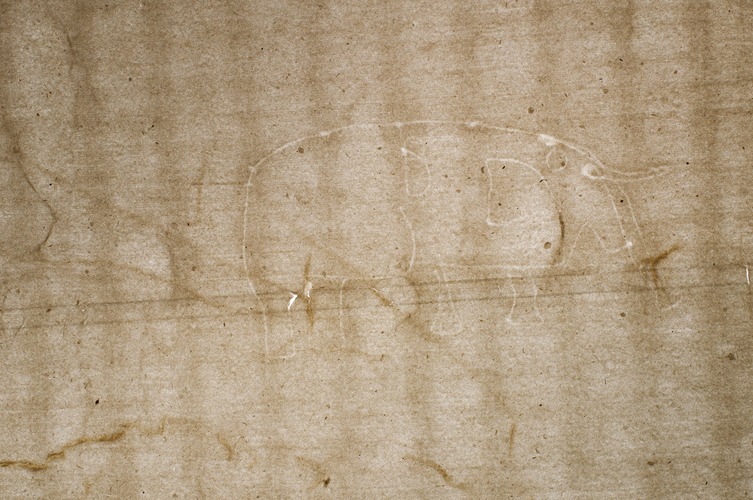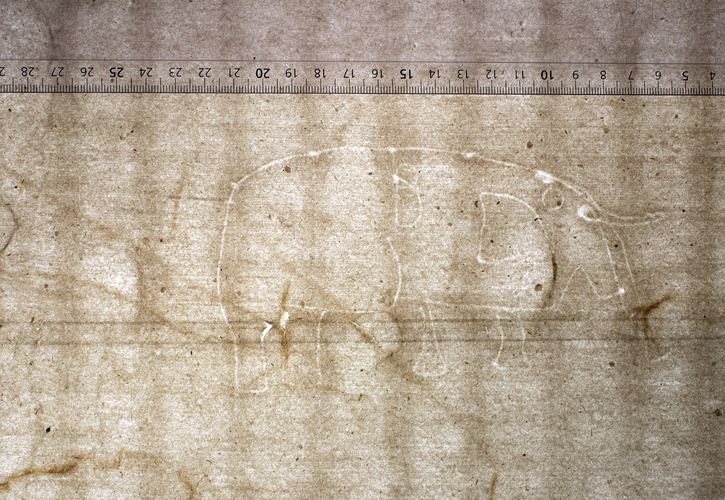[WATERMARK - ELEPHANT].
[A blank half-sheet of paper of the size called "Elephant"].
[France?, used in the Netherlands?], [ca. 1650]. Elephant folio leaf (35 x 52 cm). With a large (87 x 162 mm) elephant watermark.
€ 475
A blank half-sheet of one of the largest sizes of paper used in the seventeenth-century, a size called "Elephant" in English and "Olifant" (which means elephant) in Dutch and one of the earliest examples of the use of the elephant watermark to indicate this size. The whole untrimmed sheet probably measured about 54 x 75 cm. Its elephant watermark has a capital letter B inside the elephant near the top of its back and reads from the mould side, in the left half-sheet (so the elephant faced the centre of the sheet). The watermark measures about 87 x 162 mm. The wires that made the chainlines were unusually fine and spaced on average about 28 mm apart with the watermark in 7 chain-spaces.
The general style of the watermark is much like Heawood 1331 (found in a 1649 Blaeu atlas), which also has a roman capital B inside the elephant in the same position. Since that watermark apparently has no countermark in the other half of the sheet, ours probably didnt either. The present elephant watermark is bigger than Heawood 1331 (in fact bigger than any other we have seen), has no visible tail and the B is a bit irregular in its form, but it probably came from the same manufacturer and/or factor at about the same time, so it was probably used in the Netherlands around 1650. In this period, Blaeu used much paper manufactured in Angoumois, France, sometimes for Dutch factors (for example Pieter Haeck). The watermarked initials IB or JB in some sheets of the largest sizes might possibly mean that Joan Blaeu ordered them to his own specification. Since few bookbinders had a sewing frame large enough for an elephant folio, the Blaeu printing office and publishing house had its own bindery, which might have used paper from the same source as that used to print their atlases, so the present half-sheet could have once been an end-leaf in a Blaeu atlas.
So the elephant watermark in the present sheet and that shown as Heawood 1331 (1649, the earliest elephant watermark in Heawood) appear to have been made to indicate the large sheet size. Heawood gives no dimensions, but Blaeu offered many his largest atlases on at least two different sizes of paper, the smaller probably Imperial and the larger Elephant or Atlas (sometimes with an elephant or atlas watermark).
Briquet notes that "les papiers à léléphant sont très rares". A blank half sheet of any 17th-century paper of such a large format is a rare find, and even more so with an elephant watermark.
The half-sheet had been used recently to wrap the loose quires of a copy of the 1619 Frankfurt edition of Willem Cornelisz. Schouten. Historische Beschreibung, der wunderbarlichen Reyse. It is entirely blank except for two pencilled reference numbers. In good condition with only minor wear and two tiny tears at the central fold (which runs through the elephants legs and the lower part of its trunk, but with no significant loss). The short edges of the half-sheet had also been folded in but show no wear. A half-sheet of "Elephant" paper (ca. 1650) with a charming elephant watermark.
Related Subjects:



